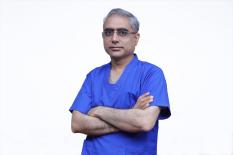About Orthopaedics and Spine Surgery
What is Spine Surgery
Spine surgery is a medical procedure that addresses a wide range of conditions affecting the spinal column, including injuries, deformities, degenerative diseases, and tumors. It includes multiple surgical procedures and approaches tailored to each patient’s specific needs. Spine surgery has become increasingly effective and safer with advancements in medical technology and surgical techniques.
Indications for Spine Surgery
Spine surgery is usually recommended when conservative treatments such as medication, physical therapy, and injections fail to minimize symptoms and affect the patient’s quality of life. Common indications for spine surgery include:
- Persistent back and neck pain
- Pain, numbness, weakness, or tingling in the arms or legs due to nerve compression
- Loss of bladder or bowel control
- Spinal instability due to fractures and spondylolisthesis
- Spinal deformities like scoliosis or kyphosis
- Severe spinal trauma, like fractures from accidents or falls
- Spinal tumors or infections
Types of Spine Surgeries
- Decompression Surgeries: These relieve pressure on spinal nerves or the spinal cord by removing bone or tissue. This type of surgery is commonly performed for conditions such as spinal stenosis, herniated discs, and foraminal stenosis. Different types of decompression surgeries are as follows:
- Discectomy: This procedure involves removing a portion of a herniated disc that presses the nerve root or the spinal cord. It aims to reduce pain, numbness, and weakness caused by nerve compression.
- Laminectomy: Laminectomy involves the removal of a portion of the lamina (the bony arch of the vertebra) to relieve pressure on the spinal cord or nerves.
- Foraminotomy: This procedure widens the neural foramen (the openings through which spinal nerves exit the spinal canal) to relieve pressure caused by foraminal stenosis or herniated discs.
- Fusion Surgeries: These aim to stabilize the spine by fusing two or more vertebrae using bone grafts, screws, rods, or cages. Fusion surgeries are recommended for conditions like degenerative disc disease, spinal instability, spinal deformities, and spinal fractures. Different types of decompression surgeries are as follows:
- Posterolateral Fusion (PLF): PLF involves the fusion of two or more vertebrae to stabilize the spine, alleviate pain, and correct deformities caused by conditions such as degenerative disc disease, spondylolisthesis, or spinal fractures.
- Anterior Cervical Discectomy and Fusion (ACDF): ACDF includes accessing the cervical spine (neck) through the front of the neck to remove a damaged disc and fuse the adjacent vertebrae. It is commonly performed to treat cervical disc herniation or degenerative disc disease.
- Transforaminal Lumbar Interbody Fusion (TLIF): TLIF is a fusion surgery performed on the lumbar spine (lower back) to treat degenerative disc disease, spinal instability, or spondylolisthesis. It involves removing the damaged disc, inserting a bone graft, and fusing the vertebrae.
- Artificial Disc Replacement (ADR): ADR, also known as total disc replacement or disc arthroplasty, replaces a damaged intervertebral disc with an artificial implant.
- Kyphoplasty and Vertebroplasty: These minimally invasive procedures stabilize vertebral compression fractures caused by osteoporosis or trauma. They involve inflating a balloon within the fractured vertebra to restore height and injecting bone cement to stabilize the fracture.
- Spinal Tumor Surgery: This surgery removes tumors or masses affecting the spinal cord or surrounding structures.
Techniques and Approaches in Spine Surgery
The techniques and approaches used during spine surgery depend on the type and location of the spinal condition. The commonly used techniques include:
- Minimally Invasive Surgery (MIS): This approach involves making small incisions and using specialized instruments and imaging techniques to access the spine with minimal disruption to surrounding tissues. MIS techniques offer advantages such as reduced blood loss, shorter hospital stays, faster recovery times, and lower complication rates than traditional open surgery.
- Microdiscectomy: This minimally invasive procedure treats herniated discs by removing the portion of the disc that is pressing on a nerve root. It typically requires a small incision and is performed under a microscope or endoscope for precision.
- Anterior Cervical Discectomy and Fusion (ACDF): In this procedure, the surgeon accesses the cervical spine (neck) through the front of the neck to remove a damaged disc and fuse the adjacent vertebrae using a bone graft. ACDF is commonly performed to relieve symptoms of cervical disc herniation or degenerative disc disease.
- Posterior Lumbar Interbody Fusion (PLIF): PLIF is a fusion surgery performed on the lumbar spine (lower back) to treat conditions such as degenerative disc disease and spondylolisthesis. It involves accessing the spine through the back, removing the damaged disc, and inserting a bone graft between the vertebrae to promote fusion.
Recent Advancements in Spine Surgery
Advancements in medical technology and surgical techniques have revolutionized spine surgery, offering patients safer and more effective treatment options.
- Robot-Assisted Surgery: Robotic surgeries offer real-time imaging and navigation, allowing spine surgeons to plan and perform procedures with greater precision and accuracy.
- 3D Printing Technology: 3D printing helps create patient-specific implants, instruments, and models for spine surgery to improve implant fit and stability.
- Motion-Preserving Technologies: These technologies use artificial disc replacement and dynamic stabilization devices to maintain spinal mobility while addressing degenerative conditions.
- Biologics and Regenerative Therapies: Biologic agents such as bone morphogenetic proteins (BMPs) and mesenchymal stem cells (MSCs) promote bone healing and tissue regeneration.
From minimally invasive procedures to advanced robot-assisted surgeries, spine surgery is paving the way for more efficient and personalized treatment options. It holds promise for further advancements in patient outcomes and quality of life. Fortis, with its team of highly skilled and experienced spine surgeons, is leveraging the advancements in the field to optimize surgical outcomes and minimize the risk of complications, helping patients toward improved spinal health and well-being.
Our Team of Experts
View allMedical Procedures for Orthopaedics and Spine Surgery
View allBreakthrough Cases
View allOur patient’s stories
View allRelated Specialities
Other Specialities
-
Explore Hospitals for Orthopaedics and Spine Surgery
Fortis Escorts Heart Institute, New Delhi Fortis Flt. Lt. Rajan Dhall Hospital, Vasant Kunj Fortis Hospital, Kalyan, Mumbai Fortis Hospital, Mohali Fortis Hospital, Noida Hiranandani Fortis Hospital, Vashi, Mumbai Fortis Hospital - Greater Noida Fortis Hospital BG Road Bangalore Fortis Hospital, Mulund, Mumbai Fortis Hospital, Richmond Road, Bengaluru Fortis Hospital CG Road Bangalore Fortis Hospital, Rajajinagar, Bengaluru -
Explore Doctors for Orthopaedics and Spine Surgery by Hospital
Doctors in Fortis Escorts Heart Institute, New Delhi Doctors in Fortis Flt. Lt. Rajan Dhall Hospital, Vasant Kunj Doctors in Fortis Hospital, Kalyan, Mumbai Doctors in Fortis Hospital, Mohali Doctors in Fortis Hospital, Noida Doctors in Hiranandani Fortis Hospital, Vashi, Mumbai Doctors in Fortis Hospital - Greater Noida Doctors in Fortis Hospital BG Road Bangalore Doctors in Fortis Hospital, Mulund, Mumbai Doctors in Fortis Hospital, Richmond Road, Bengaluru Doctors in Fortis Hospital CG Road Bangalore Doctors in Fortis Hospital, Rajajinagar, Bengaluru
























